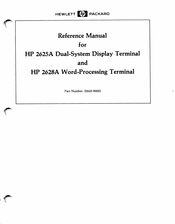HP 262SA Manuals
Manuals and User Guides for HP 262SA. We have 1 HP 262SA manual available for free PDF download: Reference Manual
HP 262SA Reference Manual (390 pages)
Dual-System Display Terminal and Word-Processing Terminal
Brand: HP
|
Category: Touch terminals
|
Size: 39.49 MB
Table of Contents
-
Introduction11
-
Graphics15
-
Introduction17
-
Format Mode24
-
Soft Reset34
-
Hard Reset35
-
Break36
-
Bell36
-
Wait36
-
Introduction37
-
Introduction65
-
Home up66
-
Home down67
-
Roll Text up73
-
Insert Line76
-
Delete Line76
-
Clear Line83
-
Tab85
-
Back Tab86
-
Introduction89
-
Format Mode97
-
Introduction99
-
Plotter Control105
-
Paper Movement106
-
Record Mode106
-
Log Top Mode107
-
Log Bottom Mode108
-
Top Logging108
-
Bottom Logging108
-
Copy Line109
-
Copy Page110
-
Copy All110
-
Introduction113
-
Character Mode122
-
Parity Checking123
-
Receive Buffer124
-
Receive Errors124
-
Sequences151
-
Monitor Mode156
-
Introduction161
-
Terminal Status164
-
Device Status175
-
Introduction179
-
Handshaking179
-
Handshake Types179
-
DC2 Transfer184
-
String Transfer196
-
Special Modes198
-
Error Messages201
-
Introduction201
-
Introduction203
-
Escape Codes212
-
Mode229
-
Swedish Keyboard242
-
German Keyboard242
-
Spanish Keyboard243
-
French Keyboard244
-
Italian Keyboard244
-
Dutch Keyboard244
-
Danish Keyboard245
-
Paper Movement258
-
Printer Modes259
-
Record Mode262
-
Log Top Mode263
-
Log Bottom Mode264
-
Bottom Logging264
-
Copy Line265
-
Copy Page266
-
Copy All C-IO266
-
Printer Paper269
-
Control Codes274
-
Commands274
-
Parameters276
-
Patterns285
-
Area Fills287
-
Pen Control297
-
Vectors298
-
ASCII Formats299
-
Binary Format301
-
Graphics Text308
-
Graphics Data318
-
HP Terminal320
-
Text321
-
4014 Emulation322
-
Graphics Status323
-
Datacomm339
-
Modem Options340
-
The Ibm Keyboard358
-
Shift Key360
-
Alt Key360
-
Shift Lock Key360
-
(A,A/A) Switch361
-
Tab Forward361
-
Back Tab361
-
New Line Key362
-
Home Key362
-
Backspace Key364
-
Cursor Blink Key364
-
Configuration382
-
Finnish Keyboard384
-
Top Logging388
Advertisement
Advertisement
